Pool Boiling Heat Transfer Characteristics of New and Recycled Alumina Nanofluids
Abstract
:1. Introduction
2. Preparation and NF Samples
Density and UV Analysis for Stability and Concentrations of Nanoparticles
3. Experimental Setup and Measurements
4. Results and Discussion
Pool Boiling Results
5. Conclusions
Author Contributions
Funding
Institutional Review Board Statement
Informed Consent Statement
Data Availability Statement
Acknowledgments
Conflicts of Interest
Nomenclature
| Al2O3 | Alumina |
| BF | Base fluid |
| BHF | Burnout heat flux |
| CHF | Critical heat flux |
| DW | Distilled water |
| d | Wire diameter |
| EG | Ethylene glycol |
| PB | Pool boiling |
| PBHTC | Pool boiling heat transfer coefficient |
| I | Current |
| L | Wire length |
| NF | Nanofluid |
| NP | Nanoparticles |
| Heat flux | |
| R | Electrical resistance |
| Tw | Wire surface temperature |
| Tsat | Saturation temperature of the fluid |
| V | Voltage |
References
- Da Silva, R.P.P.; Mortean, M.V.V.; de Paiva, K.V.; Beckedorff, L.E.; Oliveira, J.L.G.; Brandão, F.G.; Monteiro, A.S.; Carvalho, C.S.; Oliveira, H.R.; Borges, D.G.; et al. Thermal and hydrodynamic analysis of a compact heat exchanger produced by additive manufacturing. Appl. Therm. Eng. 2021, 193, 116973. [Google Scholar] [CrossRef]
- Abou Elmaaty, T.M.; Kabeel, A.E.; Mahgoub, M. Corrugated plate heat exchanger review. Renew. Sustain. Energy Rev. 2017, 70, 852–860. [Google Scholar] [CrossRef]
- Inbaoli, A.; Sujith Kumar, C.S.; Jayaraj, S. A review on techniques to alter the bubble dynamics in pool boiling. Appl. Therm. Eng. 2022, 214, 118805. [Google Scholar] [CrossRef]
- Mahmoud, M.M.; Karayiannis, T.G. Pool boiling review: Part I–Fundamentals of boiling and relation to surface design. Therm. Sci. Eng. Prog. 2021, 25, 101024. [Google Scholar] [CrossRef]
- Ajeeb, W.; Murshed, S.M.S. Nanofluids in Compact Heat exchangers for Thermal Applications: A State-of-the-Art Review. Therm. Sci. Eng. Prog. 2022, 30, 101276. [Google Scholar] [CrossRef]
- Ajeeb, W.; Oliveira, M.S.A.; Martins, N.; Murshed, S.M.S. Forced convection heat transfer of non-Newtonian MWCNTs nanofluids in microchannels under laminar flow. Int. Commun. Heat Mass Transf. 2021, 127, 105495. [Google Scholar] [CrossRef]
- Ajeeb, W.; da Silva, R.R.T.; Murshed, S.S. Experimental investigation of heat transfer performance of Al2O3 nanofluids in a compact plate heat exchanger. Appl. Therm. Eng. 2023, 218, 119321. [Google Scholar] [CrossRef]
- Ajeeb, W.; Murshed, S.M.S. Comparisons of Numerical and Experimental Investigations of the Thermal Performance of Al2O3 and TiO2 Nanofluids in a Compact Plate Heat Exchanger. Nanomaterials 2022, 12, 3634. [Google Scholar] [CrossRef]
- Murshed, S.M.S.; Leong, K.C.; Yang, C. Thermophysical and electrokinetic properties of nanofluids—A critical review. Appl. Therm. Eng. 2008, 28, 2109–2125. [Google Scholar] [CrossRef]
- Younes, H.; Mao, M.; Murshed, S.M.S.; Lou, D.; Hong, H.; Peterson, G.P. Nanofluids: Key parameters to enhance thermal conductivity and its applications. Appl. Therm. Eng. 2022, 207, 118202. [Google Scholar] [CrossRef]
- Nikulin, A.; Moita, A.S.; Moreira, A.L.N.; Murshed, S.M.S.; Huminic, A.; Grosu, Y.; Faik, A.; Nieto-maestre, J.; Khliyeva, O. Effect of Al2O3 nanoparticles on laminar, transient and turbulent flow of isopropyl alcohol. Int. J. Heat Mass Transf. 2019, 130, 1032–1044. [Google Scholar] [CrossRef]
- Cacua, K.; Buitrago-Sierra, R.; Herrera, B.; Pabón, E.; Murshed, S.M.S. Nanofluids’ stability effects on the thermal performance of heat pipes: A critical review. J. Therm. Anal. Calorim. 2019, 136, 1597–1614. [Google Scholar] [CrossRef]
- Roque, D.; Ajeeb, W.; Murshed, S.M.S.; Pereira, J.M.C. Forced Convection Heat Transfer Characteristics of Al2O3 Nanofluids in a Minichannel—An Experimental Study. J. Phys. Conf. Ser. 2021, 2116, 012056. [Google Scholar] [CrossRef]
- Ajeeb, W.; Oliveira, M.S.A.; Martins, N.; Murshed, S.M.S. Performance evaluation of convective heat transfer and laminar flow of non-Newtonian MWCNTs in a circular tube. Therm. Sci. Eng. Prog. 2021, 25, 101029. [Google Scholar] [CrossRef]
- Fabre, E.; Mancin, S.; Murshed, S.M.S. Boiling Features and Performances of Nanofluids. In Fundamentals and Transport Properties of Nanofluids; Murshed, S.M.S., Ed.; The Royal Society of Chemistry: London, UK, 2022; ISBN 978-1-83916-419-4. [Google Scholar]
- Ajeeb, W.; Murshed, S.M.S. Numerical Study of Convective Heat Transfer Performance, entropy generation and energy efficiency of Al and Al2O3 Nanofluids in Minichannel. J. Nanofluids 2023, 12, 18–28. [Google Scholar] [CrossRef]
- Ajeeb, W.; Roque, D.; Murshed, S.M.S. Thermal-Hydraulic Performance of Al2O3 Nanofluids under Laminar Flow in a Minitube. Int. J. Energy Clean Environ. 2022, 23, 39–59. [Google Scholar] [CrossRef]
- Murshed, S.M.S.; Nieto De Castro, C.A.; Loureno, M.J.V.; Lopes, M.L.M.; Santos, F.J.V. A review of boiling and convective heat transfer with nanofluids. Renew. Sustain. Energy Rev. 2011, 15, 2342–2354. [Google Scholar] [CrossRef]
- Kim, S.J. Pool Boiling Heat Transfer Characteristics of Nanofluids. Ph.D. Thesis, Massachusetts Institute of Technology, Cambridge, MA, USA, 2007. [Google Scholar]
- Truong, B.H. Determination of Pool Boiling Critical Heat Flux Enhancement in Nanofluids; Massachusetts Institute of Technology: Cambridge, MA, USA, 2007; Volume 8. [Google Scholar]
- Murshed, S.M.S.; Milanova, D.; Kumar, R. An Experimental Study of Surface Tension-Dependent Pool Boiling Characteristics of Carbon Nanotubes-Nanofluids. In Proceedings of the ASME 2009 7th International Conference on Nanochannels, Microchannels and Minichannels, Pohang, Republic of Korea, 22–24 June 2009. [Google Scholar]
- Pare, A.; Ghosh, S.K. The empirical characteristics on transient nature of Al2O3-water nanofluid pool boiling. Appl. Therm. Eng. 2021, 199, 117617. [Google Scholar] [CrossRef]
- Wang, L.; Ye, W.; He, X.; Wu, S.; Ming, P.; Wang, J.; Cheng, H.; Yan, B. Experimental study on the CHF enhancement effect of nanofluids on the oxidized low carbon steel surface. Appl. Therm. Eng. 2022, 204, 117968. [Google Scholar] [CrossRef]
- Mori, S.; Yokomatsu, F.; Utaka, Y. Enhancement of critical heat flux using spherical porous bodies in saturated pool boiling of nanofluid. Appl. Therm. Eng. 2018, 144, 219–230. [Google Scholar] [CrossRef]
- Hadžić, A.; Može, M.; Arhar, K.; Zupančič, M.; Golobič, I. Effect of Nanoparticle Size and Concentration on Pool Boiling Heat Transfer with TiO2 Nanofluids on Laser-Textured Copper Surfaces. Nanomaterials 2022, 12, 2611. [Google Scholar] [CrossRef] [PubMed]
- Dadjoo, M.; Etesami, N.; Esfahany, M.N. Influence of orientation and roughness of heater surface on critical heat flux and pool boiling heat transfer coefficient of nanofluid. Appl. Therm. Eng. 2017, 124, 353–361. [Google Scholar] [CrossRef]
- Ma, X.; Song, Y.; Wang, Y.; Yao, S.; Vafai, K. Amelioration of pool boiling thermal performance utilizing graphene-silver hybrid nanofluids. Powder Technol. 2022, 397, 117110. [Google Scholar] [CrossRef]
- Ciloglu, D.; Bolukbasi, A. A comprehensive review on pool boiling of nanofluids. Appl. Therm. Eng. 2015, 84, 45–63. [Google Scholar] [CrossRef]
- Azmi, W.H.; Abdul Hamid, K.; Mamat, R.; Sharma, K.V.; Mohamad, M.S. Effects of working temperature on thermo-physical properties and forced convection heat transfer of TiO2 nanofluids in water-Ethylene glycol mixture. Appl. Therm. Eng. 2016, 106, 1190–1199. [Google Scholar] [CrossRef] [Green Version]
- Wen, T.; Lu, L.; Zhang, S.; Zhong, H. Experimental study and CFD modelling on the thermal and flow behavior of EG/water ZnO nanofluid in multiport mini channels. Appl. Therm. Eng. 2021, 182, 116089. [Google Scholar] [CrossRef]
- Ashrae. ASHRAE Handbook: Fundamentals; American Society of Heating, Refrigerating and Air-Conditioning Engineers: Peachtree Corners, GA, USA, 2005; ISBN 1523-7230. [Google Scholar]
- Park, S.D.; Bang, I.C. Experimental study of a universal CHF enhancement mechanism in nanofluids using hydrodynamic instability. Int. J. Heat Mass Transf. 2014, 70, 844–850. [Google Scholar] [CrossRef]
- Sharma, P.O.; Unune, D.R. Colloids and Surfaces A: Physicochemical and Engineering Aspects Augmentation of pool boiling performance using Ag/ZnO hybrid nanofluid over EDM assisted robust heater surface modification. Colloids Surfaces A Physicochem. Eng. Asp. 2022, 655, 130150. [Google Scholar] [CrossRef]
- Kumar, P.C.M.; Muruganandam, M. Stability analysis of heat transfer MWCNT with different base fluids. J. Appl. Fluid Mech. 2017, 10, 51–59. [Google Scholar]
- Ravi Babu, S.; Sambasivarao, G. Thermo-physical properties of water +ethylene glycol basedalumina nanofluids. J. Mech. Eng. Res. Dev. 2018, 41, 168–176. [Google Scholar] [CrossRef]
- Cacua, K.; Murshed, S.M.S.; Pabón, E.; Buitrago, R. Dispersion and thermal conductivity of TiO2/water nanofluid. J. Therm. Anal. Calorim. 2020, 140, 109–114. [Google Scholar] [CrossRef]
- Baek, S.; Shin, D.; Kim, G.; Lee, A.; Noh, J.; Choi, B.; Huh, S.; Jeong, H.; Sung, Y. Influence of amphoteric and anionic surfactants on stability, surface tension, and thermal conductivity of Al2O3/water nanofluids. Case Stud. Therm. Eng. 2021, 25, 100995. [Google Scholar] [CrossRef]
- Ji, J.; Yao, X.; Gao, J.; Lu, W.; Wang, W.; Chu, D. Effect of surfactants and pH values on stability of γ-Al2O3 nanofluids. Chem. Phys. Lett. 2021, 781, 138996. [Google Scholar] [CrossRef]
- Milanova, D.; Kumar, R. Heat transfer behavior of silica nanoparticles in pool boiling experiment. J. Heat Transfer 2008, 130, 1–6. [Google Scholar] [CrossRef]
- Vassallo, P.; Kumar, R.; D’Amico, S. Pool boiling heat transfer experiments in silica–water nano-fluids. Int. J. Heat Mass Transf. 2004, 47, 407–411. [Google Scholar] [CrossRef]
- Sarafraz, M.M.; Hormozi, F. Pool boiling heat transfer to dilute copper oxide aqueous nanofluids. Int. J. Therm. Sci. 2015, 90, 224–237. [Google Scholar] [CrossRef]
- Song, S.L.; Lee, J.H.; Chang, S.H. CHF enhancement of SiC nanofluid in pool boiling experiment. Exp. Therm. Fluid Sci. 2014, 52, 12–18. [Google Scholar] [CrossRef]
- Meena, C.S.; Das, A.K. Boiling Heat Transfer on Cylindrical Surface: An Experimental Study. Heat Transf. Eng. 2022, 44, 689–701. [Google Scholar] [CrossRef]
- Vafaei, S. Nanofluid pool boiling heat transfer phenomenon. Powder Technol. 2015, 277, 181–192. [Google Scholar] [CrossRef]
- Wang, G.; Zhang, Z.; Wang, R.; Zhu, Z. A review on heat transfer of nanofluids by applied electric field or magnetic field. Nanomaterials 2020, 10, 2386. [Google Scholar] [CrossRef]
- Wang, R.; Chen, T.; Qi, J.; Du, J.; Pan, G.; Huang, L. Investigation on the heat transfer enhancement by nanofluid under electric field considering electrophorestic and thermophoretic effect. Case Stud. Therm. Eng. 2021, 28, 101498. [Google Scholar] [CrossRef]
- Modi, M.; Kangude, P.; Srivastava, A. Performance evaluation of alumina nanofluids and nanoparticles-deposited surface on nucleate pool boiling phenomena. Int. J. Heat Mass Transf. 2020, 146, 118833. [Google Scholar] [CrossRef]
- Kouloulias, K.; Sergis, A.; Hardalupas, Y.; Barrett, T.R. Visualisation of subcooled pool boiling in nanofluids. Fusion Eng. Des. 2019, 146, 153–156. [Google Scholar] [CrossRef]
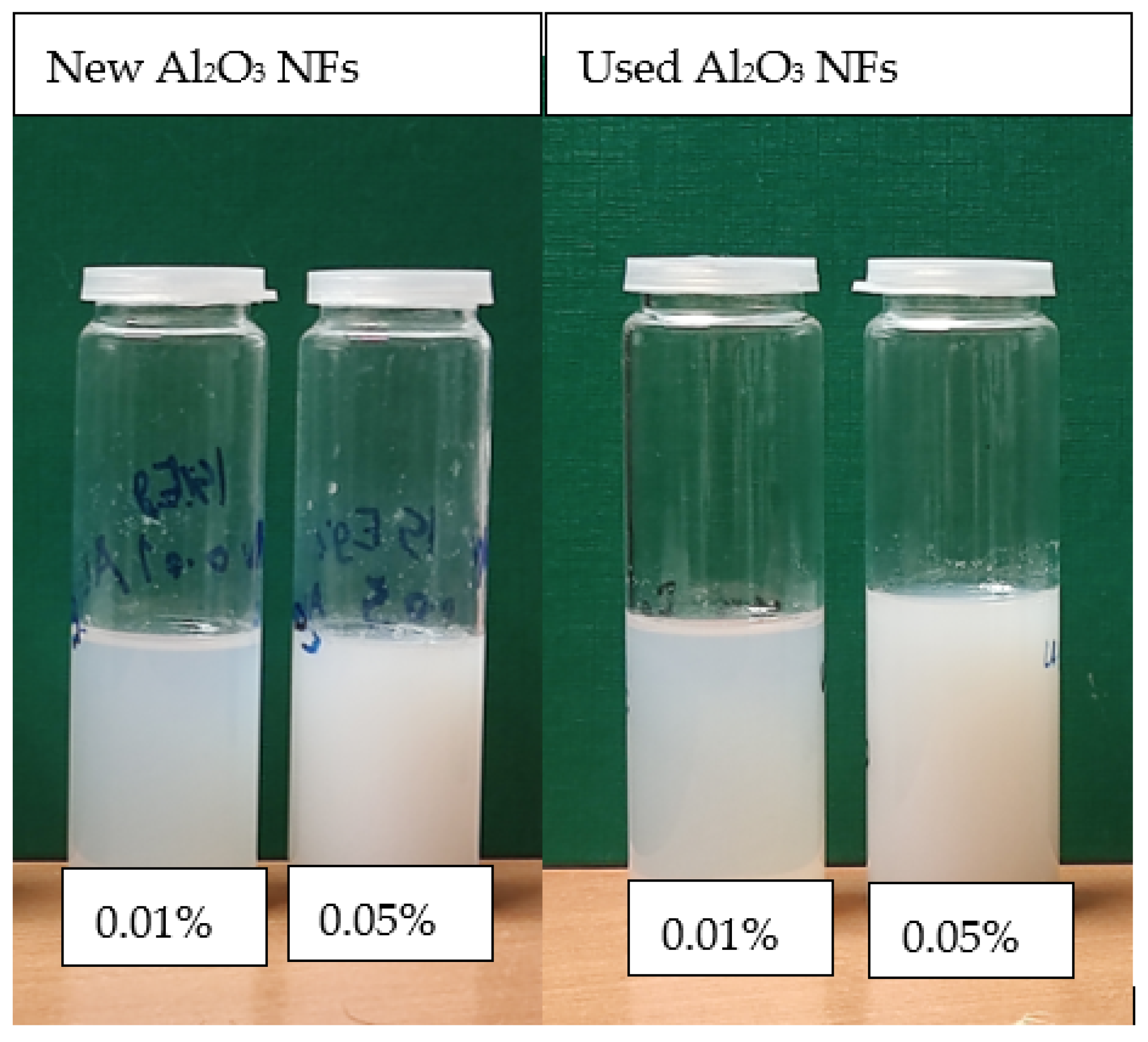
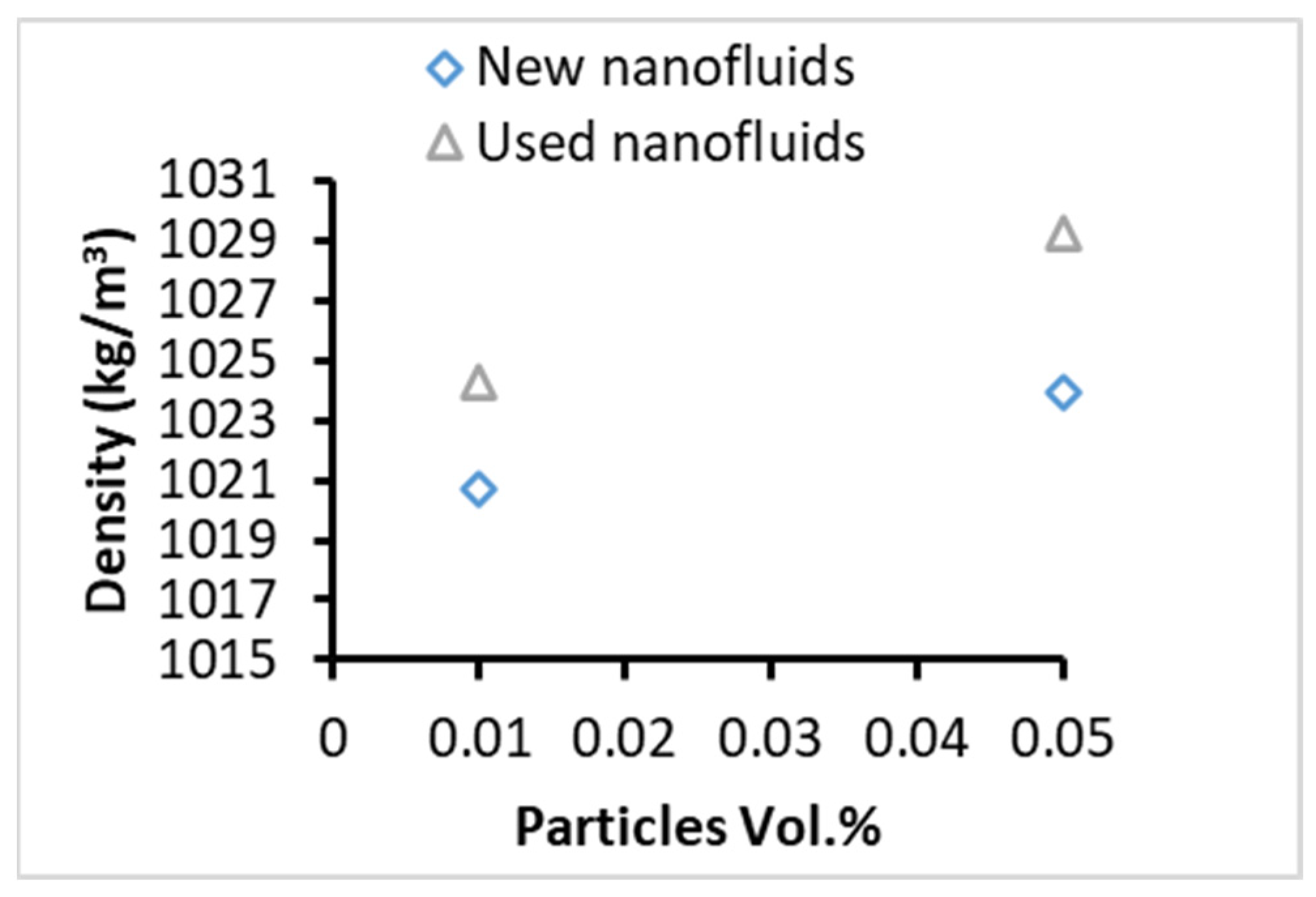
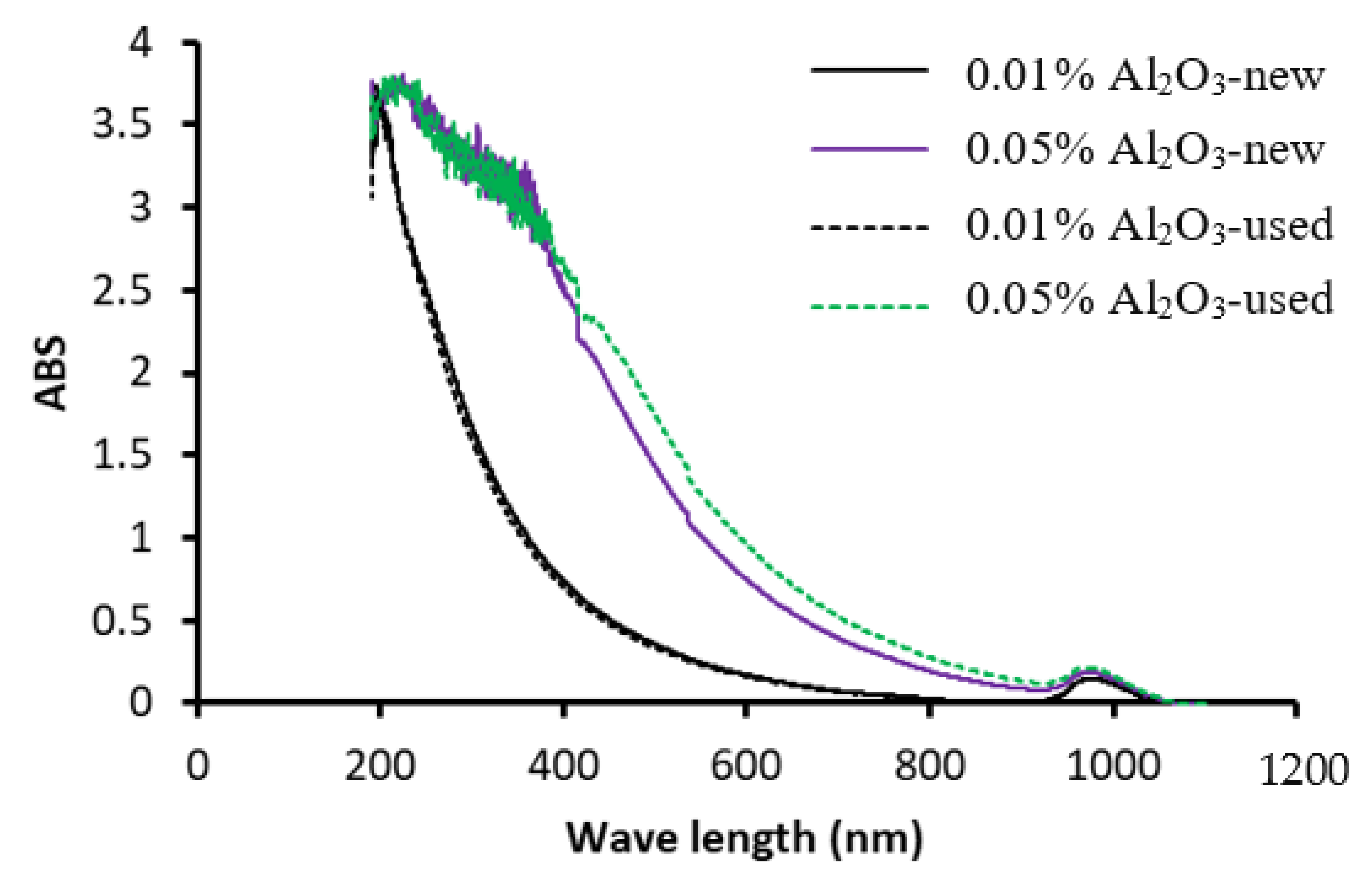

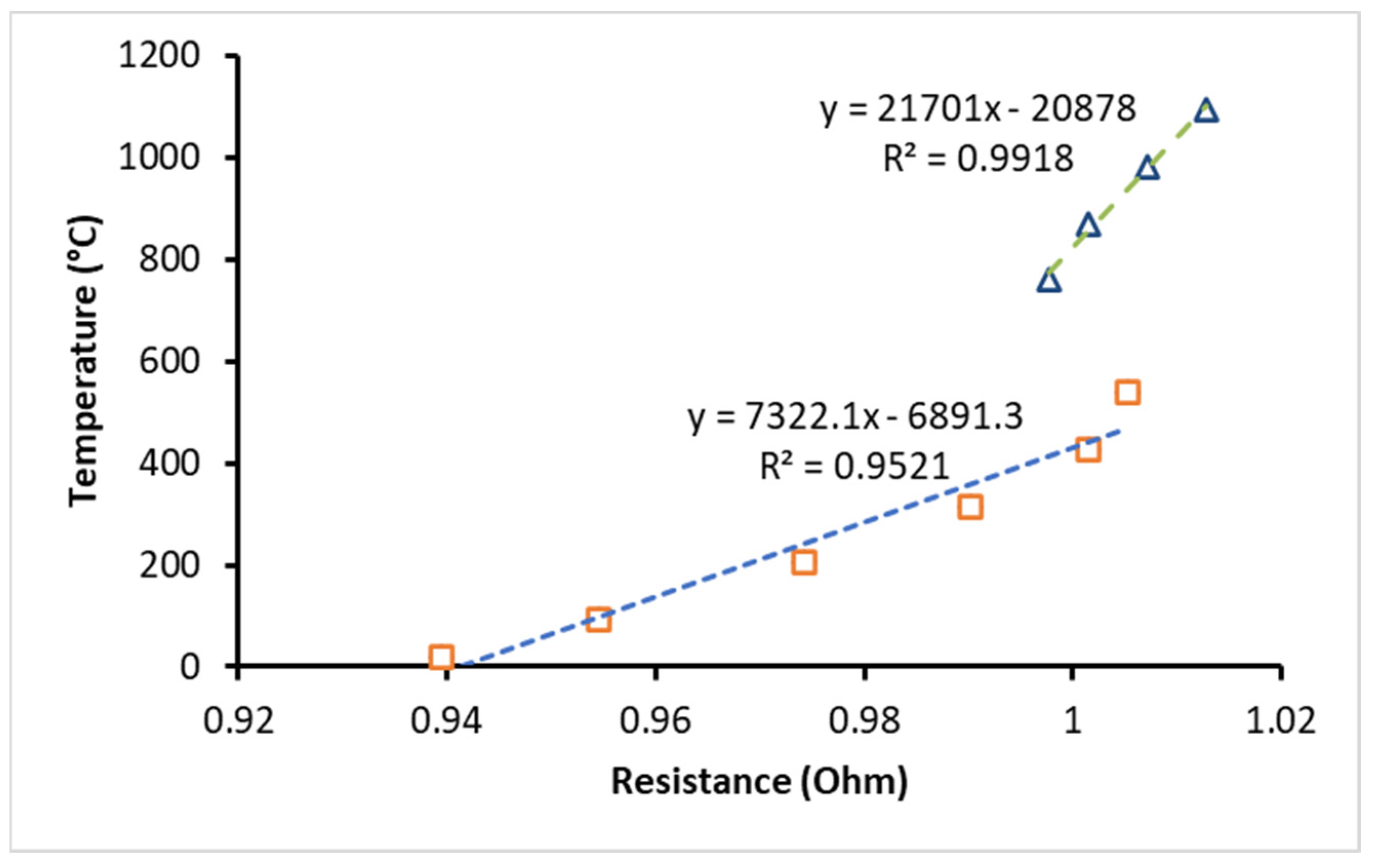
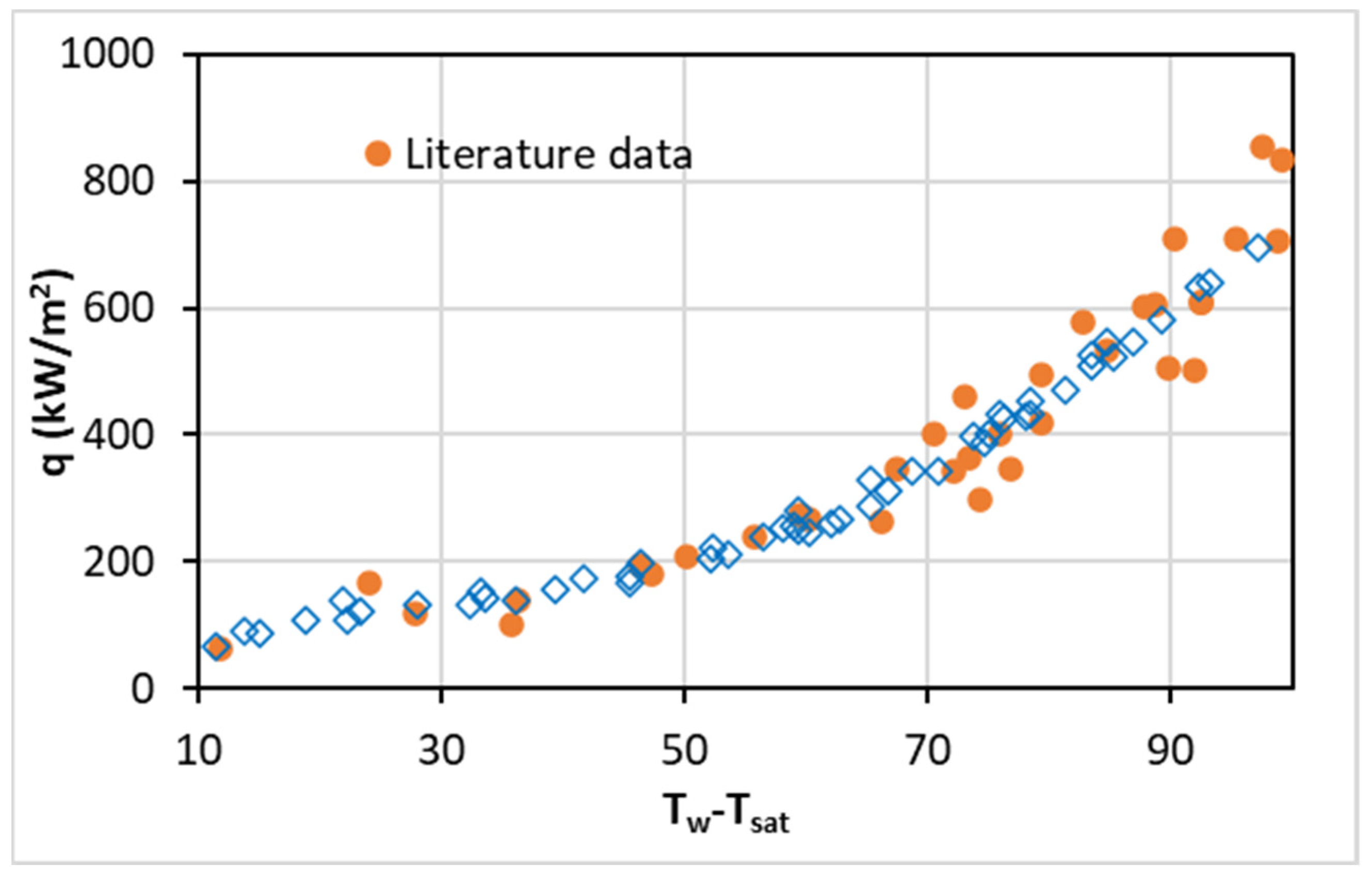

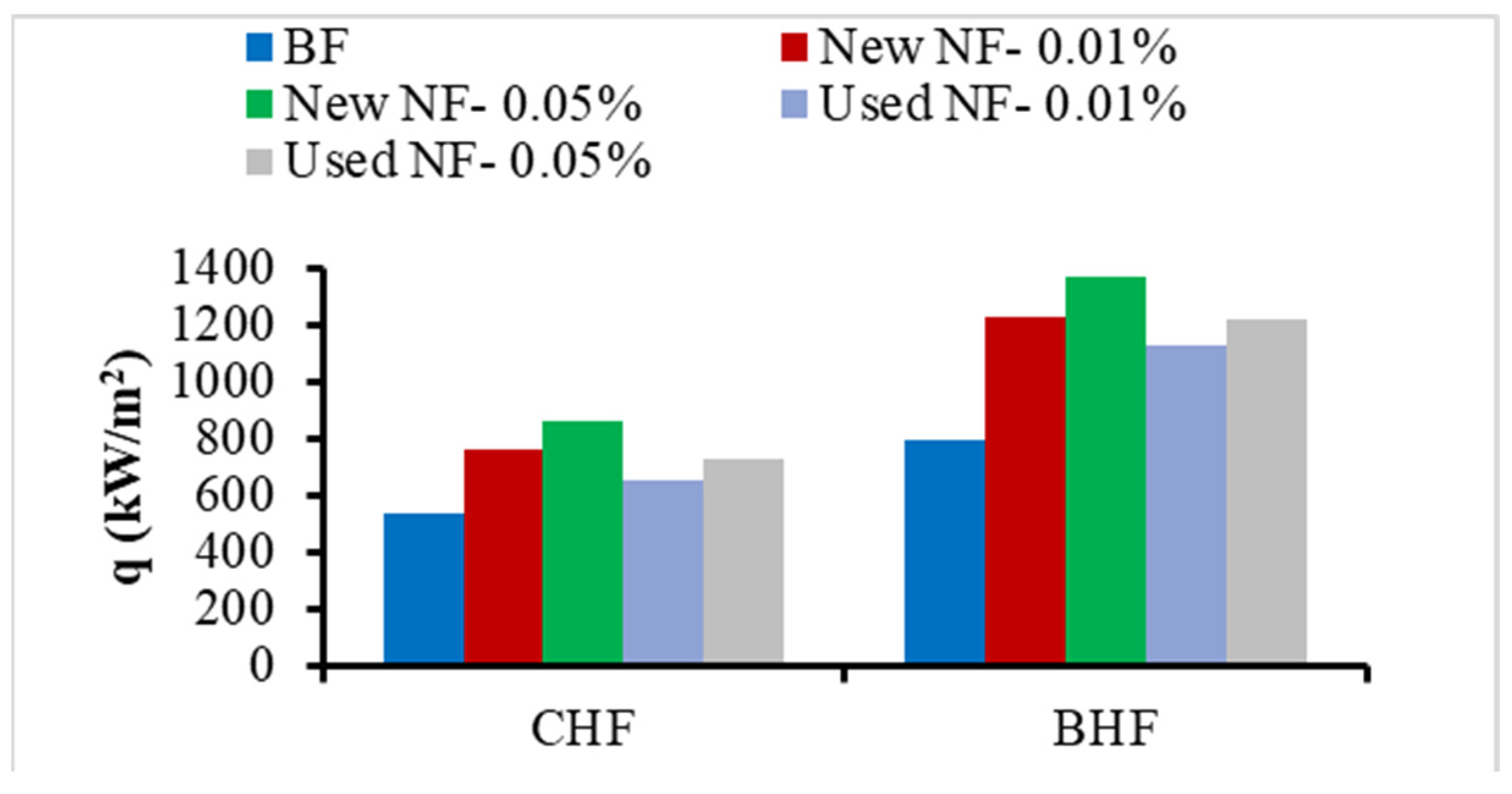

Disclaimer/Publisher’s Note: The statements, opinions and data contained in all publications are solely those of the individual author(s) and contributor(s) and not of MDPI and/or the editor(s). MDPI and/or the editor(s) disclaim responsibility for any injury to people or property resulting from any ideas, methods, instructions or products referred to in the content. |
© 2023 by the authors. Licensee MDPI, Basel, Switzerland. This article is an open access article distributed under the terms and conditions of the Creative Commons Attribution (CC BY) license (https://creativecommons.org/licenses/by/4.0/).
Share and Cite
Ajeeb, W.; Murshed, S.M.S. Pool Boiling Heat Transfer Characteristics of New and Recycled Alumina Nanofluids. Nanomaterials 2023, 13, 1040. https://doi.org/10.3390/nano13061040
Ajeeb W, Murshed SMS. Pool Boiling Heat Transfer Characteristics of New and Recycled Alumina Nanofluids. Nanomaterials. 2023; 13(6):1040. https://doi.org/10.3390/nano13061040
Chicago/Turabian StyleAjeeb, Wagd, and S. M. Sohel Murshed. 2023. "Pool Boiling Heat Transfer Characteristics of New and Recycled Alumina Nanofluids" Nanomaterials 13, no. 6: 1040. https://doi.org/10.3390/nano13061040





